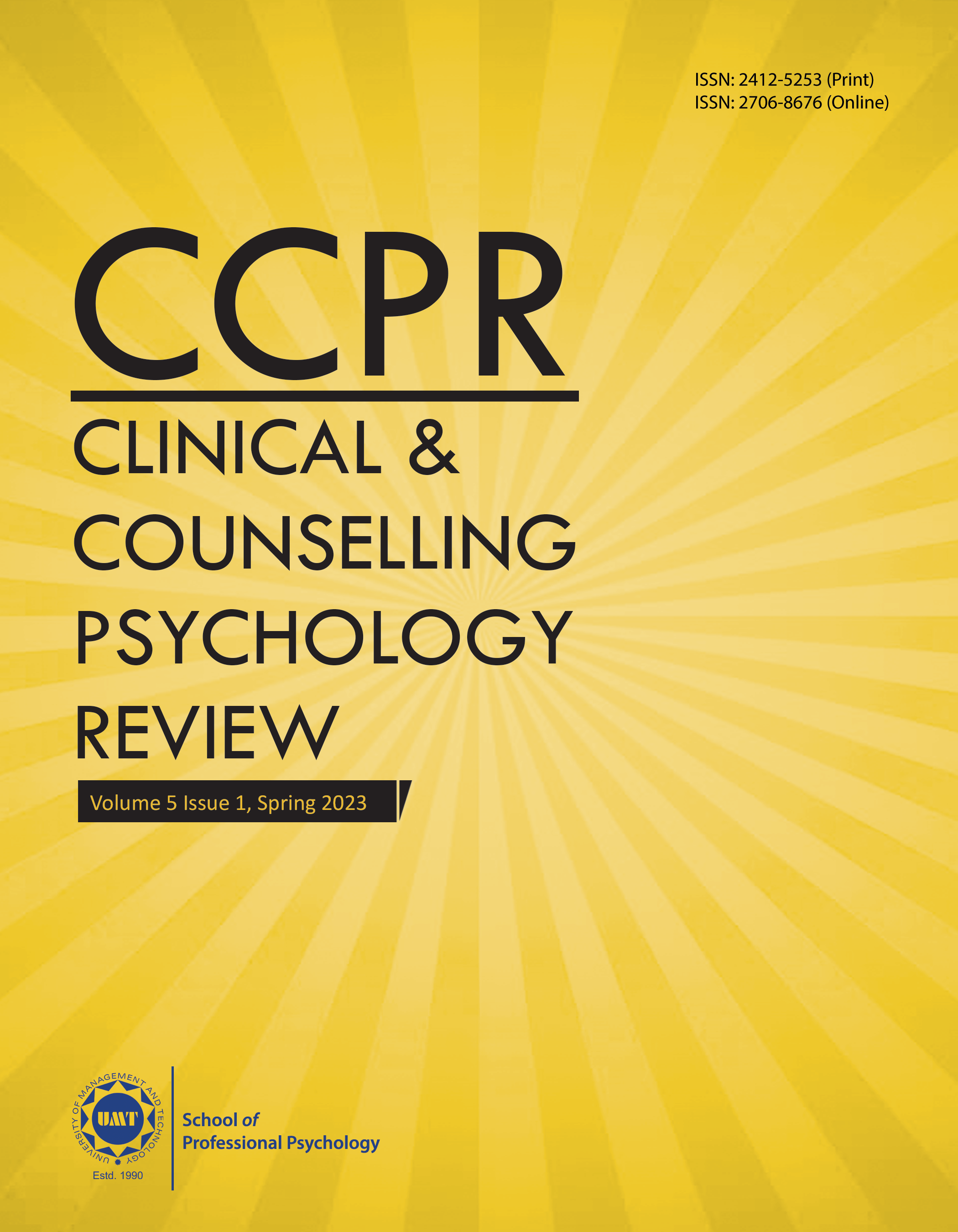Use of Behavioral Modification and Sensory Integration Strategies to Manage Symptoms of Autism Spectrum Disorder (ASD)
Abstract
 Abstract Views: 0
Abstract Views: 0
Autism spectrum disorder (ASD) is a neurodevelopmental condition characterized by symptoms in two domains: Social communication/social interaction and restricted, repetitive patterns of behavior, interests, or activities. The impairments associated with ASD often become challenging in the clinical setting due to their broader impact across developmental domains. Therefore, recent evidence suggests a combination of behavioral and sensory integration strategies in managing ASD. Several carefully designed interventional studies have also provided information about the effects of caregiver training and direct instruction at the interventional level. The current study presents the case of a four years and six months old boy who was referred with complaints of poor socialization and communication and repetitive behaviors. This study was based on a single case-ABA design. Initial assessment of the client involved several steps including a clinical interview, behavioral observation, administration of Sensory Screening Checklist followed by a diagnostic assessment based on the Childhood Autism Rating Scale (CARS 2) and diagnostic criteria provided by DSM-5 TR. Based on the assessment, the diagnosis of ASD was confirmed and a management plan was formulated to address the presenting issues. A total of 26 therapy sessions were carried out with the client that particularly focused on managing repetitive behaviors using a combination of behavioral and sensory integration strategies. Outcome analysis revealed that the client demonstrated a reduction in behaviors including teeth grinding and echolalia. The therapy sessions proved beneficial in addressing the client's challenges, albeit with further work needed to achieve optimal outcomes.
Downloads
References
Al-Dawaideh, A.M. (2014). The effectiveness of cues - pause - point method for overcoming echolalia in Arabic-Speaking children with autism. Life Science Journal. 11(1), 72–82.
Alrehaili, R. A., ElKady, R. M., Alrehaili, J. A., & Alreefi, R. M. (2023). Exploring early childhood autism spectrum disorders: A comprehensive review of diagnostic approaches in young children. Cureus, 15(12), Article e50111. https://doi.org/10.7759/cureus.50111
American Psychiatric Association. (2013). Diagnostic and statistical manual of mental disorders (5th ed.). https://doi.org/10.1176/appi.books.9780890425596
American Psychiatric Association. (2022). Diagnostic and statistical manual of mental disorders (5th ed., text rev.). https://doi.org/10.1176/appi.books.9780890425787
Anderson, D. K., Maye, M. P., & Lord, C. (2011). Changes in maladaptive behaviors from Midchildhood to young adulthood in autism spectrum disorder. American Journal on Intellectual and Developmental Disabilities, 116(5), 381–397. https://doi.org/10.1352/1944-7558-116.5.381
Aquila, P., Yack, E., & Sutton, S. (2015). Building bridges through sensory integration, 3rd edition: Therapy for children with autism and other pervasive developmental disorders (3rd ed.). Future Horizons.
Boterberg, S., Charman, T., Marschik, P. B., Bölte, S., & Roeyers, H. (2019). Regression in autism spectrum disorder: A critical overview of retrospective findings and recommendations for future research. Neuroscience & Biobehavioral Reviews, 102, 24–55. https://doi.org/10.1016/j.neubiorev.2019.03.013
Dellapiazza, F., Michelon, C., Oreve, M. J., Robel, L., Schoenberger, M., Chatel, C., Vesperini, S., Maffre, T., Schmidt, R., Blanc, N., Vernhet, C., Picot, M. C., Baghdadli, A., & ELENA study group (2020). The impact of atypical sensory processing on adaptive functioning and maladaptive behaviors in autism spectrum disorder during childhood: Results from the ELENA Cohort. Journal of Autism and Developmental Disorders, 50(6), 2142–2152. https://doi.org/10.1007/s10803-019-03970-w
Edelstein, M.L., Sloman, K., Selver, K. (2021). Effects of demand complexity on echolalia in students with autism. Behavior Analysis in Practice, 14(4). 984–990 https://doi.org/10.1007%2Fs40617-020-00535-7
Efaw, H. E. (2021). Review of the use of differential reinforcement in skill acquisition [Master’s thesis; University of South Florida]. Digital Commons @ University of South Florida. https://digitalcommons.usf.edu/cgi/viewcontent.cgi?article=9961&context=etd
Feldman, J. I., Cassidy, M., Liu, Y., Kirby, A. V., Wallace, M. T., & Woynaroski, T. G. (2020). Relations between sensory responsiveness and features of autism in children. Brain Sciences, 10(11), Article e775. https://doi.org/10.3390/brainsci10110775
Garbacz, S. A., McIntyre, L. L., & Santiago, R. T. (2016). Family involvement and parent–teacher relationships for students with autism spectrum disorders. School Psychology Quarterly, 31(4), 478–490. https://doi.org/10.1037/spq0000157
Glennon, T. J. (2021). Sensory integration (SI) therapy. In F. R. Volkmar (Ed.) Encyclopedia of autism spectrum disorders (pp. 4243-4250. Springer. https://doi.org/10.1007/978-3-319-91280-6_1199
Gomez, R., & Cooper, A. (2008). Reinforcement sensitivity theory and mood induction studies. In P. J. Corr (Ed.), The reinforcement sensitivity theory of personality (pp. 291-316). Cambridge University Press. https://doi.org/10.1017/CBO9780511819384.010
Howlin, P. (1982). Echolalic and spontaneous phrase speech in autistic children. Journal of Child Psychology and Psychiatry, and Allied Disciplines, 23(3), 281–293. https://doi.org/10.1111/j.1469-7610.1982.tb00073.x
Jamal Uddin, M., Hasan, M. M., & Parvin, M. S. (2021). A comparative study on sensory integration treatment and behavioral modification treatment for the children with hyperactivity and autism spectrum disorder. International Journal of Intellectual Disability, 2(1), 18–23.
Kandaswamy, R. (2017). Bruxism (teeth grinding) in autism and how to stop it: The permanent solution. International Journal of Development Research, 7(1), 11343–11345.
Kapp, S. K., Steward, R., Crane, L., Elliott, D., Elphick, C., Pellicano, E., & Russell, G. (2019). 'People should be allowed to do what they like': Autistic adults' views and experiences of stimming. Autism: The International Journal of Research and Practice, 23(7), 1782–1792. https://doi.org/10.1177/1362361319829628
Kasari, C., Gulsrud, A., Freeman, S., Paparella, T., & Hellemann, G. (2012). Longitudinal follow-up of children with autism receiving targeted interventions on joint attention and play. Journal of the American Academy of Child & Adolescent Psychiatry, 51(5), 487–495. https://doi.org/10.1016/j.jaac.2012.02.019
Khaledi, H., Aghaz, A., Mohammadi, A., Dadgar, H., & Meftahi, G. H. (2022). The relationship between communication skills, sensory difficulties, and anxiety in children with autism spectrum disorder. Middle East Current Psychiatry, 29, Article e69. https://doi.org/10.1186/s43045-022-00236-7
Lyall, K., Croen, L., Daniels, J., Fallin, M. D., Ladd-Acosta, C., Lee, B. K., Park, B. Y., Snyder, N. W., Schendel, D., Volk, H., Windham, G. C., & Newschaffer, C. (2017). The changing epidemiology of autism spectrum disorders. Annual Review of Public Health, 38, 81–102. https://doi.org/10.1146/annurev-publhealth-031816-044318
Little, L. M., Ausderau, K., Freuler, A., Sideris, J., & Baranek, G. T. (2022). Caregiver strategies to sensory features for children with autism and developmental disabilities. Frontiers in Psychology, 13, Article e905154. https://doi.org/10.3389/fpsyg.2022.905154
Lord, C., & Jones, R. M. (2013). New strategies and findings for behavioral interventions in autism spectrum disorders. Annals of the New York Academy of Sciences, 1304(1), 70–76. https://doi.org/10.1111/nyas.12311
McMorrow, M. J., & Foxx, R. M. (1986). Some direct and generalized effects of replacing an autistic man's echolalia with correct responses to questions. Journal of Applied Behavior Analysis, 19(3), 289–297. https://doi.org/10.1901/jaba.1986.19-289
Moussa, H. N., Srikrishnan, A., Blackwell, S. C., Dash, P., & Sibai, B. M. (2016). Fetal origins of autism spectrum disorders: the non-associated maternal factors. Future Science OA, 2(2), Article eFSO114. https://doi.org/10.4155/fsoa-2015-0001
Neely, L., Gerow, S., Rispoli, M., Lang, R., & Pullen, N. (2016). Treatment of echolalia in individuals with autism spectrum disorder: A systematic review. Review Journal of Autism and Developmental Disorders, 3(1), 82–91. https://doi.org/10.1007/s40489-015-0067-4
O'Donnell, S., Deitz, J., Kartin, D., Nalty, T., & Dawson, G. (2012). Sensory processing, problem behavior, adaptive behavior, and cognition in preschool children with autism spectrum disorders. The American Journal of Occupational Therapy: Official Publication of the American Occupational Therapy Association, 66(5), 586–594. https://doi.org/10.5014/ajot.2012.004168
Park, Y., & Kong, I. (2015). A systematic review of effects on sensory integration intervention based on the vestibular-proprioceptive system for children in Korea. Journal of Korean Society of Sensory Integration Therapists, 13(2), 53–61. https://doi.org/10.18064/jkasi.2015.13.2.053
Pfeiffer, B. A., Koenig, K., Kinnealey, M., Sheppard, M., & Henderson, L. (2011). Effectiveness of sensory integration interventions in children with autism spectrum disorders: A pilot study. The American Journal of Occupational Therapy: Official Publication of the American Occupational Therapy Association, 65(1), 76–85. https://doi.org/10.5014/ajot.2011.09205
Sandbank, M., Bottema-Beutel, K., Crowley LaPoint, S., Feldman, J. I., Barrett, D. J., Caldwell, N., Dunham, K., Crank, J., Albarran, S., & Woynaroski, T. (2023). Autism intervention meta-analysis of early childhood studies (Project AIM): Updated systematic review and secondary analysis. BMJ, 383, Article e076733. https://doi.org/10.1136/bmj-2023-076733
Sari, N. P., Jansen, P. W., Blanken, L. M. E., Ruigrok, A. N. V., Prinzie, P., Tiemeier, H., Baron-Cohen, S., van IJzendoorn, M. H., & White, T. (2022). Maternal age, autistic-like traits and mentalizing as predictors of child autistic-like traits in a population-based cohort. Molecular Autism, 13(1), Article e26. https://doi.org/10.1186/s13229-022-00507-4
Scarff, M. (2016). Functional analysis and treatment of bruxism in children with autism spectrum disorder [Master’s thesis, University of South Florida]. Digital Commons @ University of South Florida. https://digitalcommons.usf.edu/cgi/viewcontent.cgi?article=7778&context=etd
Schopler, E., Van Bourgondien, M. E., Wellman, G. J., & Love, S. R. (2010). Childhood Autism Rating Scale (CARS 2) (2nd ed.). Western Psychological Services.
Tromans, S., & Adams, C. (2018). Brief report: Autism spectrum disorder: A comprehensive survey of randomized controlled trials. Journal of Autism and Developmental Disorders, 48(9), 3228–3232. https://doi.org/10.1007/s10803-018-3569-y
Valentino, A. L., Shillingsburg, M. A., Conine, D. E., & Powell, N. M. (2012). Decreasing echolalia of the instruction “say” during echoic training through the use of the cues-pause-point procedure. Journal of Behavioral Education, 21(4), 315–328. https://doi.org/10.1007/s10864-012-9155-z
Whitehouse, A., Varcin, K., Waddington, H., Sulek, R., Bent, C., Ashburner, J., Eapen, V., Goodall, E., Hudry, K., Roberts, J., Silove, N., & Trembath, D. (2020). Interventions for children on the autism spectrum: A synthesis of research evidence. Autism Cooperative Research Centre. https://www.autismcrc.com.au/sites/default/files/interventions-evidence/Full_Report_Interventions_for_children_on_the_autism_spectrum_-_A_synthesis_of_research_evidence.pdf
Williams, K. L., Kirby, A. V., Watson, L. R., Sideris, J., Bulluck, J., & Baranek, G. T. (2018). Sensory features as predictors of adaptive behaviors: A comparative longitudinal study of children with autism spectrum disorder and other developmental disabilities. Research in Developmental Disabilities, 81, 103–112. https://doi.org/10.1016/j.ridd.2018.07.002








